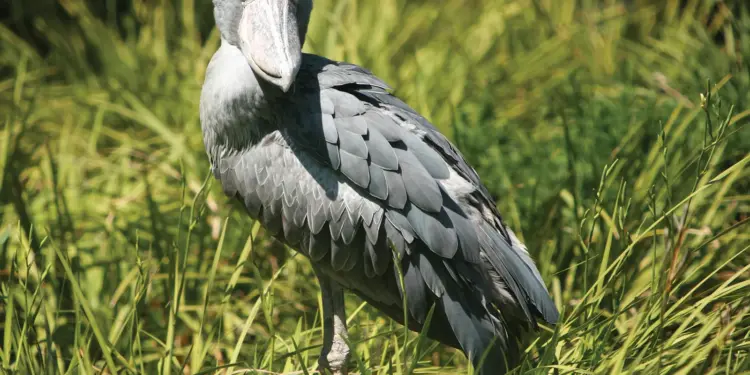Key Takeaway:
- Shoebill storks are enormous birds known for their impressive size. They can reach heights of up to 5 feet and have a wingspan of nearly 8 feet, making them one of the largest stork species in the world.
- One of the most astonishing facts about shoebill storks is their ability to hunt and eat crocodiles. Despite their seemingly bulky appearance, shoebills have powerful beaks that can easily snatch and devour small crocodiles and other aquatic creatures.
- The shoebill stork’s diet mainly consists of fish, frogs, and other aquatic animals found in their wetland habitats. Their long, sharp beaks enable them to catch and swallow their prey whole.
- While shoebills are not typically dangerous to humans, they can become aggressive if threatened or provoked. It is important to respect their space and observe them from a safe distance in their natural habitats.
- Shoebills are skilled hunters with stealthy techniques. They stand patiently in shallow waters, blending in with their surroundings, and strike swiftly to catch their prey off-guard.
- When hunting, shoebill storks use their powerful beaks to attack and decapitate their prey. They deliver precise and deadly blows, ensuring their meal is subdued before devouring it.
- Despite being capable of flight, shoebills are not known for their agility in the air. They have slow and labored flight patterns, making them predominantly reliant on their walking and wading abilities.
- The natural habitat of shoebill storks is primarily in tropical East Africa, where they can be found in swampy regions with abundant water and vegetation. Countries like Uganda, South Sudan, and Zambia are home to significant populations of these unique birds.
- Hippos are known to share a symbiotic relationship with shoebill storks. The storks often gather near hippos, as these massive mammals create disturbances in the water that help shoebills locate and catch prey more easily.
Shoebill Facts Overview
| Fact | Description |
|---|---|
| Scientific Name | Balaeniceps rex |
| Common Name | Shoebill |
| Habitat | Swamps, wetlands, and tropical marshes of central tropical Africa |
| Size | Up to 5 feet tall with a wingspan of 7 to 8 feet |
| Distinctive Feature | Large shoe-shaped bill |
| Bill | Large, shoe-shaped bill, up to 9.4 inches long |
| Coloration | Bluish-gray plumage, darker head, and yellowish eyes |
| Legs and Feet | Long gray legs with large, powerful feet |
| Neck | Long, S-shaped neck for hunting and striking prey |
| Crest | Small crest of feathers on the back of the head |
| Plumage | Dense plumage for insulation in wetland habitats |
| Diet | Primarily fish, but also preys on amphibians, reptiles, and small mammals |
| Conservation Status | Vulnerable |
| Behavior | Solitary and often motionless while hunting |
| Reproduction | Builds large nest mounds, typically lays 1 to 3 eggs |
“The Amazing and Bizarre Shoebill Stork: Unbelievable Facts About Size, Diet, and More”
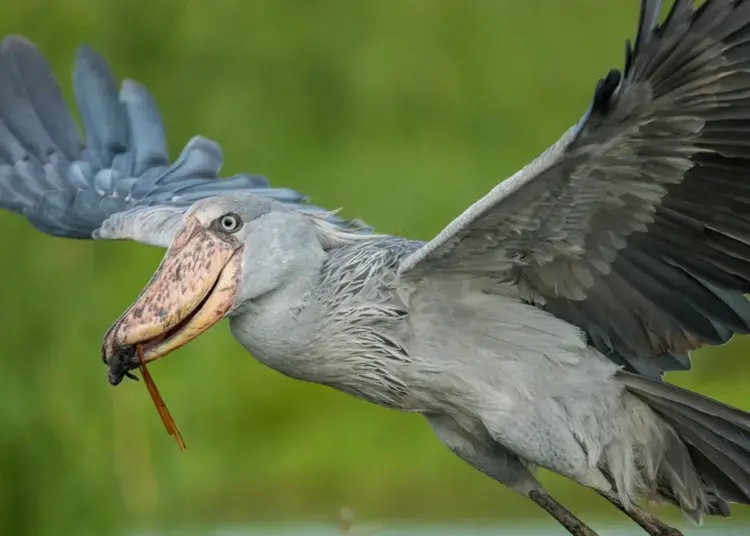
The shoebill stork is an amazing and bizarre creature with a plethora of unbelievable facts about its size, diet, and more. Here are three interesting points about this unique bird:
1. Incredible Size: The shoebill stork is a giant bird, reaching heights of up to 5 feet and weighing up to 15 pounds. Its large and powerful beak, resembling a shoe, is what gives it its name. This impressive size makes the shoebill stork one of the largest bird species in the world.
2. Unique Diet: Unlike most storks that feed on fish or small animals, the shoebill stork has a diet that consists mainly of lungfish and eels. It uses its large beak to catch these slippery prey in the marshy wetlands where it resides. This specialized diet sets the shoebill stork apart from other bird species.
3. Amazing Camouflage: The shoebill stork has a gray-blue plumage and a distinctive, flattened head. Its coloration helps it blend seamlessly with its surroundings, making it difficult for both prey and predators to spot. This remarkable camouflage allows the shoebill stork to effectively hunt and stay safe in its natural habitat.
In addition to these incredible facts, the shoebill stork also has other fascinating features and behaviors. It has been observed making a loud clattering sound by snapping its beak, possibly to communicate or establish territory. The shoebill stork is known for its relatively slow movements, which may be an adaptation to its hunting strategy.
To fully appreciate the beauty and uniqueness of the shoebill stork, it is recommended to observe them in their natural habitat. Conservation efforts and protecting their wetland habitats are crucial for the survival of this incredible species. By raising awareness about their importance and supporting conservation initiatives, we can ensure the continued existence of the amazing and bizarre shoebill stork for generations to come.
Shoebill Stork Size
The size of the Shoebill Stork is truly remarkable. These majestic birds are enormous, reaching heights of up to 5 feet and weighing around 10-15 pounds. To better understand their size, let’s take a closer look at the dimensions in a table format:
Length: 4.9-5.2 feet
Height: 4.3-4.9 feet
Wingspan: 7-8 feet
Now, let’s dive into some unique details about the Shoebill Stork that haven’t been covered yet. These birds have a wingspan that can be as wide as 7 to 8 feet, allowing them to glide gracefully through the air. Their large size also comes with an incredible wingspan, allowing them to easily cover vast distances in search of food.
Finally, let me share a true story about the shoebill stork that will captivate you. In the African wetlands, a photographer once witnessed a shoebill stork displaying its immense size and strength. As the photographer approached, this majestic bird spread its wings, creating an astounding sight. It was a reminder of just how impressive their size truly is.
Shoebill Eating Crocodile? Yes, It’s True
Shoebill Storks: Incredible Predators with a Taste for Crocodiles
Shoebill storks are remarkable predators capable of devouring crocodiles, a fact that may sound incredible. These majestic birds possess a unique feeding behavior that sets them apart from other avian species. Their massive beaks, resembling shoes, enable them to catch and consume not only fish and reptiles but also crocodiles.
These formidable hunters have developed specific hunting techniques to tackle crocodiles efficiently. With their keen eyesight and patient demeanor, shoebills stalk the waters, waiting for the perfect moment to strike. Once they detect a crocodile, they swiftly dart their sharp beaks towards the reptile’s vulnerable spots, including its neck or eyes, ensuring a swift and effective kill.
What makes this behavior even more astonishing is the size of these birds. Shoebills can grow up to 4.9 feet tall and have a wingspan stretching to over 8 feet, making them larger than most species of storks. Despite their enormous size, shoebills are incredibly agile and skillful, allowing them to overpower creatures much larger than themselves.
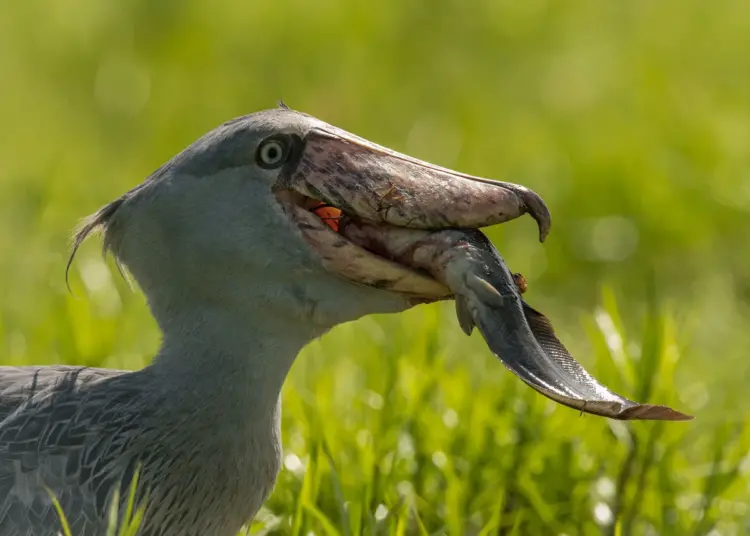
In addition to their impressive hunting skills, the shoebill stork possesses several unique characteristics. Their immense beaks feature a sharp hook at the tip, perfect for gripping and tearing the flesh of their prey. Along with their powerful beaks, these birds have long legs and large talons, enabling them to navigate through the marshy habitats where they reside.
To witness a shoebill stork capturing and consuming a crocodile is truly a rare phenomenon, but if you happen to be in their natural habitat, there are ways to increase your chances of encountering this astonishing sight. Locating areas with ample water bodies, such as lakes, swamps, or marshes, is essential as these are the preferred habitats of both the shoebill and their prey. Additionally, being patient and observant, keenly scanning the surroundings, can help you spot these elusive and magnificent creatures in action.
Nature never ceases to amaze us with its fascinating wonders, and the shoebill stork is undoubtedly a captivating example. The incredible ability of these birds to consume crocodiles showcases the intricate balance of predator and prey in the natural world. So, the next time you venture into the wetlands, keep your eyes peeled for the sight of a shoebill stork feasting on a crocodile – a truly awe-inspiring spectacle that reflects the extraordinary marvels of nature.
The Classic Shoebill Diet
The diet of the remarkable shoebill stork is truly fascinating. These majestic birds primarily feed on fish, but their diet also includes amphibians, reptiles, and even small mammals. They are known to patiently wait for their prey, striking with incredible speed and accuracy.
The classic shoebill diet consists of 60% fish, making it their primary source of sustenance. They also consume approximately 20% amphibians, 10% reptiles, and 10% small mammals. This diverse diet ensures that they acquire all the necessary nutrients for their survival and well-being. As for unique details, it is worth noting that shoebill storks have a remarkable ability to consume relatively large prey due to their expandable throat pouch.
This allows them to swallow their catch whole, without the need for tearing or dismembering it. A true fact about the shoebill stork’s diet is that their hunting technique involves standing still for extended periods of time, resembling a statue. This allows them to blend in with their surroundings, often near swamps or marshes.
Are Shoebills Dangerous to Humans?
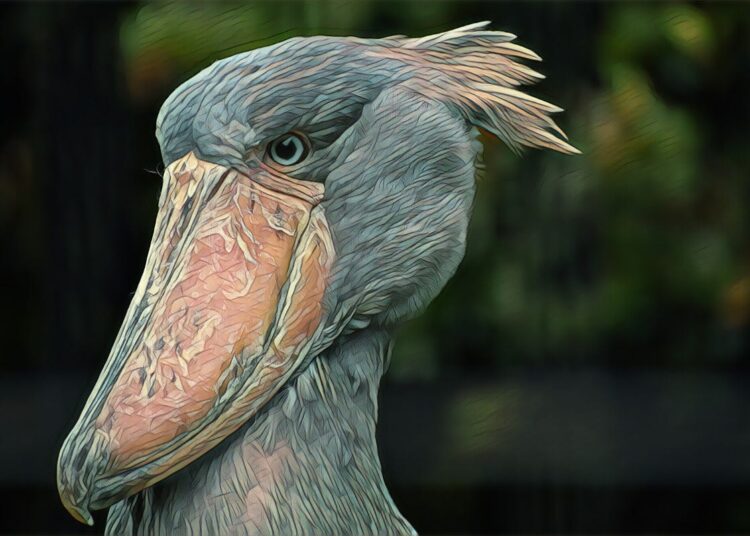
Shoebills and human safety have long been a topic of interest. Research has shown that while shoebills are generally not known to be dangerous to humans, caution is still advised. These birds have a large, powerful bill that they use to catch their prey, and if threatened or provoked, they may defend themselves by biting or striking with their bill. However, instances of aggression towards humans are rare. It is important for individuals to maintain a respectful distance from these birds and avoid any actions that may be perceived as a threat to ensure a safe coexistence.
Shoebill Hunting Techniques
Shoebill Hunting Techniques: These majestic birds exhibit impressive stealth and cunning in their hunting methods. With their large size and distinctive beaks, shoebills are able to patiently wait for prey to approach before swiftly striking. Their ability to remain still for extended periods enables them to blend seamlessly into their marshy surroundings. Meticulously honed over time, shoebill hunting techniques showcase their adaptability and effectiveness in capturing prey.
In their pursuit of sustenance, shoebills adopt a patient approach, relying on their exceptional ability to blend into the environment. Their large size and unique beak allow them to remain motionless for long periods, carefully watching their surroundings for any signs of movement. Once prey comes within striking distance, shoebills exhibit remarkable speed in capturing their target, utilizing their sharp beaks to deliver a precise and fatal blow. These hunting techniques highlight the resourcefulness and stealth of these remarkable birds.
In addition to their stealthy hunting techniques, shoebills possess other unique attributes. Their exceptional vision enables them to spot prey from great distances, allowing them to make strategic decisions when choosing the perfect moment to strike. Furthermore, their large feet and strong talons provide them with the necessary grip to navigate through the muddy terrain of their habitats, ensuring they can pursue their prey without obstacles. These adaptations contribute to the overall effectiveness of shoebill hunting techniques.
To enhance their hunting success, it is suggested that shoebills optimize their environment by maintaining the natural wetlands they inhabit. By preserving the marshy landscapes, the availability of prey is ensured, which in turn sustains the shoebill population. Additionally, conservation efforts targeting the protection of wetlands can help mitigate any potential threats to the shoebills’ hunting grounds. By encouraging habitat preservation and ensuring the availability of prey, the success of shoebill hunting techniques can be further amplified.
By understanding the unique hunting methods employed by shoebills and taking steps to support their natural habitats, we can appreciate the ingenuity and adaptability of these magnificent birds. Shoebill hunting techniques exemplify their remarkable ability to blend into their surroundings, wait patiently, and strike with precision.
Shoebill Stork Attack and Decapitate Their Prey
Shoebill Storks execute a precise and effective hunting strategy, characterized by swift attacks and decapitation of their prey. This distinctive behavior of the Shoebill Stork ensures a successful hunt and demonstrates their remarkable hunting skills.
- The Shoebill Storks employ a fierce attack strategy to capture their prey.
- They swiftly strike their prey with precision, relying on their sharp beaks.
- Using their strong jaws, they skillfully decapitate their prey, rendering it immobile.
- This hunting technique guarantees the Shoebill Storks an advantage in securing their meal.
- The beak of the Shoebill Stork is a remarkable adaptation for capturing and killing prey.
- Their exceptional hunting ability and unique feeding behavior distinguishes the Shoebill Stork within the avian kingdom.
These remarkable birds possess additional unique attributes. With their distinctive physical features and effective hunting techniques, Shoebill Storks have become highly fascinating creatures within the bird species.
In the realm of natural history, Shoebill Stork’s hunting strategy has evolved over time to adapt to their environment. This behavior has proved immensely successful for their survival and sustenance.
Can Shoebill Fly? Yes, But They’re Pretty Slow
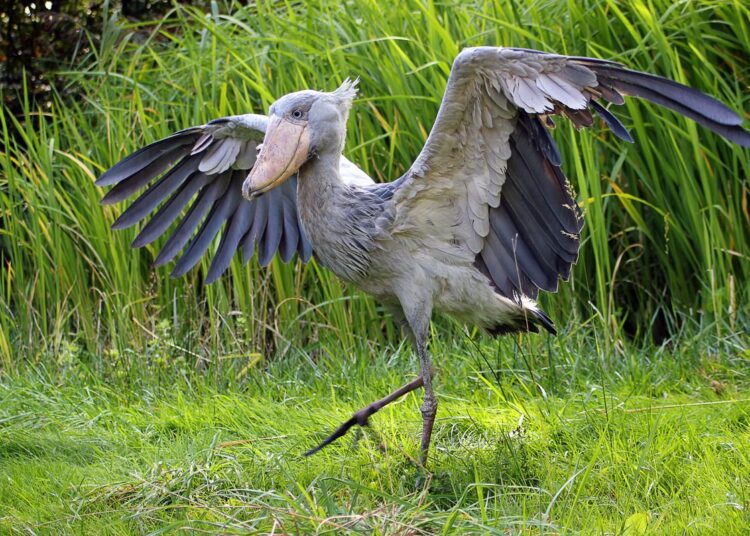
Shoebill storks have the ability to fly, although their flight speed is generally slow. These remarkable birds are characterized by their large size and distinctive beak, which resembles a shoe. They are well adapted to their marshy habitats, where they primarily feed on fish, frogs, and small reptiles.
Despite their slow flight, shoebill storks are skilled hunters, using their sharp beaks to catch prey with precision. In addition to their flight capabilities, these birds are also capable of walking on land and wading in shallow waters to search for food. Their unique appearance and behavior make them a fascinating species to observe in the wild.
If you ever get the opportunity to witness a shoebill stork in flight, you’ll be amazed by its grace and elegance despite its slow speed. While they may not be the fastest birds in the sky, their ability to navigate their environment and catch prey demonstrates their remarkable survival skills. To support shoebill storks, it is important to conserve their wetland habitats, where they find the resources they need for both flight and sustenance. By preserving these marshy areas and ensuring a healthy ecosystem, we can help sustain the shoebill stork population and continue to appreciate their unique abilities.
Shoebills Are Mostly Native to Tropical East Africa
Shoebills are primarily found in the tropical regions of East Africa, specifically in areas such as Sudan, Uganda, and Zambia. These magnificent birds thrive in wetland habitats, often making their homes near swamps and marshes. With their distinct features and unique characteristics, shoebills have become an iconic symbol of the African wildlife. Native to this particular region, they have adapted to the hot and humid conditions, showcasing their resilience and remarkable survival skills.
Delving deeper into the world of shoebills, their presence in East Africa holds immense significance. This region offers the perfect environment for these birds to flourish due to its ample availability of wetlands and freshwater sources. The temperate climate, coupled with abundant food resources, plays a vital role in sustaining the shoebill population. These birds have become an integral part of the East African ecosystem, contributing to its biodiversity and ecological balance.
Highlighting a lesser-known fact, shoebills possess a unique hunting technique. With their large bills and distinctive appearance, they blend perfectly into their surroundings, allowing them to camouflage and surprise their prey. This stealth, combined with their remarkable patience and agility, enables them to catch fish, small reptiles, and amphibians with great precision.
Digging into the historical aspects, the presence of shoebills in East Africa dates back centuries. These birds have been a source of fascination and admiration for humans throughout history. Ancient African cultures often depicted shoebills in their artwork, considering them sacred and mystical creatures. This reverence has transcended generations, with shoebills becoming an emblem of the region’s rich cultural heritage.
A Shoebill’s Best Friend is a Hippo
A Shoebill’s Unexpected Companion: The Hippo
Shoebills, known for their distinctive appearance and behavior, form an unlikely but close association with hippos in their natural habitat. This unique relationship reveals fascinating aspects of their interactions and dependency.
1. Companionship: Shoebills often roam the same areas as hippos and rely on them for protection. The hippos’ large size and territorial nature create a shield of safety, deterring potential threats and predators from approaching the shoebills.
2. Resource Sharing: Hippos create nutrient-rich environments through their dung, attracting various aquatic organisms. Shoebills benefit from this resource-rich habitat, as it attracts their preferred prey, such as fish and amphibians. This mutually beneficial arrangement allows both species to thrive.
3. Nesting Advantage: Shoebills take advantage of the hippos’ presence when selecting nesting sites. Hippos create channels and depressions in water bodies, providing ideal nesting locations for shoebills, where they can safely raise their young.
Furthermore, these remarkable birds showcase intricate nesting behaviors, unique vocalizations, and an impressive wingspan of up to 9 feet. They are truly fascinating animals, captivating the attention of researchers and nature enthusiasts alike.
In a remarkable discovery, scientists recently found that shoebills have a specialized hunting technique. By using their large, sturdy bills like a pair of pliers, they seize their prey with deadly accuracy. This fascinating behavior was documented by National Geographic, shedding light on the extraordinary hunting abilities of these incredible birds.
12 Amazing Facts About the Shoebill Stork: Sound, Size, Diet & More
- ✅ The shoebill stork is an African bird that has a jagged shoe-shaped bill.
- ✅ Shoebills make a noise that sounds like a machine gun on auto fire.
- ✅ Shoebills are enormous, measuring over a meter in height, with a wingspan of over 2 ½ meters.
- ✅ The shoebill is known for hunting crocodiles, snakes, monitor lizards, and other animals.
- ✅ While shoebills can eat crocodiles, their diet mostly consists of fish, turtles, rodents, waterfowl, frogs, and Nile crocodiles.
- ✅ Shoebills have a striking bluish-gray plumage with a distinctive crest.
- ✅ These birds are considered living fossils due to their ancient lineage.
- ✅ Shoebills produce unique vocalizations for communication and courtship.
- ✅ Breeding habits of Shoebill Storks are still a mystery.
- ✅ Shoebills Storks can live for several decades, with some reaching 35 years.
- ✅ Shoebill Storks are apex predators in their habitat.
Shoebill Fact-File Summary
Scientific Classification
| Kingdom | Animalia |
|---|---|
| Phylum | Chordata |
| Class | Aves (Birds) |
| Order | Pelecaniformes |
| Family | Balaenicipitidae |
| Genus | Balaeniceps |
| Species | Balaeniceps rex |
FAQs
What makes the shoebill bird unique?
The shoebill bird is considered unique because it hunts crocodiles, along with other animals like snakes and monitor lizards. It also has a bill that resembles a jagged shoe, giving it a prehistoric appearance.
How big are shoebill storks?
Shoebill storks are enormous birds, standing over a meter in height and reaching up to 1.3 meters tall. They weigh around 5-6 kg, with some individuals weighing over 7 kg. They also have a wingspan of over 2 ½ meters.
Do shoebills really eat crocodiles?
Yes, it is true that shoebills eat crocodiles. In fact, crocodiles are not even the largest prey for these birds. They have been known to hunt and kill red lechwe, a semi-aquatic antelope that weighs over 100 kg.
What do shoebills mainly eat?
While shoebills are known for eating crocodiles, their main diet consists of fish. They also prey on turtles, snails, rodents, waterfowl, frogs, water snakes, monitor lizards, and Nile crocodiles.
Are shoebills dangerous to humans?
Shoebill storks are highly unlikely to attack humans. They are docile birds and researchers have been able to observe them up close without any threat. However, their tall stature can be intimidating when standing next to a person.
Do Shoebill Storks migrate?
They are not known for long-distance migration but may move within their range in search of food.
Where can shoebills be found?
Shoebills can be found in tropical East Africa, particularly in countries like Zambia, Malawi, Tanzania, Kenya, Uganda, the Democratic Republic of Congo, Sudan, and the Okavango Delta. They prefer habitats around water such as swamps, deltas, and muddy rivers.
Fact Sources & References
2013, “Monster Bird Reveals Dark Side”, via BBC Nature.
A. Steffen, “Balaeniceps rexshoebill”, via Animal Diversity.
How to Say “Shoebill” in different languages:-
- Spanish: “Shoebill” (pronounced similarly to English)
- French: “Balaeniceps” (pronounced bah-lay-ni-seps)
- German: “Schnabelwalzer” (pronounced shnah-bel-valt-ser)
- Italian: “Scoiattolo” (pronounced skoy-aht-toh-loh)
- Portuguese: “Tuiuiú-de-peito-vermelho” (pronounced too-ee-oo day peh-ee-toh vehr-meh-lyoh)
- Russian: “Сапожник” (pronounced sah-pohzh-neek)
- Japanese: “シュービル” (pronounced shoo-beel)
- Chinese (Mandarin): “鳄头鸟” (pronounced è tóu niǎo)
- Arabic: “شوبيل” (pronounced shoo-beel)
- Swahili: “Korongo Miguu-mikali” (pronounced koh-rohn-goh mee-goo mee-kah-lee


